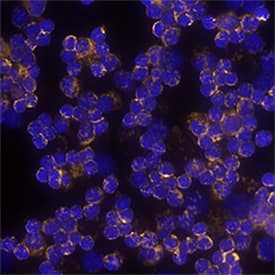Mouse BAFF/BLyS/TNFSF13B Biotinylated Antibody
R&D Systems, part of Bio-Techne | Catalog # BAF2106


Key Product Details
Species Reactivity
Validated:
Cited:
Applications
Validated:
Cited:
Label
Antibody Source
Product Specifications
Immunogen
Ala127-Leu309
Accession # Q9WU72
Specificity
Clonality
Host
Isotype
Scientific Data Images for Mouse BAFF/BLyS/TNFSF13B Biotinylated Antibody
BAFF/BLyS/TNFSF13B in Mouse Splenocytes.
BAFF/BLyS/TNFSF13B was detected in immersion fixed mouse splenocytes using Goat Anti-Mouse BAFF/BLyS/TNFSF13B Biotinylated Antigen Affinity-purified Polyclonal Antibody (Catalog # BAF2106) at 10 µg/mL for 3 hours at room temperature. Cells were stained using the NorthernLights™ 557-conjugated Streptavidin (red; Catalog # NL999) and counterstained with DAPI (blue). Specific staining was localized to cytoplasm.Applications for Mouse BAFF/BLyS/TNFSF13B Biotinylated Antibody
Immunocytochemistry
Sample: Immersion fixed mouse splenocytes
Western Blot
Sample: Recombinant Mouse BAFF/BLyS/TNFSF13B (Catalog # 2106-BF)
Formulation, Preparation, and Storage
Purification
Reconstitution
Formulation
Shipping
Stability & Storage
- 12 months from date of receipt, -20 to -70 °C as supplied.
- 1 month, 2 to 8 °C under sterile conditions after reconstitution.
- 6 months, -20 to -70 °C under sterile conditions after reconstitution.
Background: BAFF/BLyS/TNFSF13B
BAFF (also known as TALL-1, BLyS, THANK) is a type II transmembrane glycoprotein belonging to the TNF superfamily and has been designated as TNF superfamily member 13B (TNFSF13B). Mouse BAFF is a 309 aa protein consisting of a 248 aa extracellular domain, a 21 aa transmembrane region and a 45 aa cytoplasmic tail (1, 2). BAFF has the typical structural characteristics of the TNF superfamily ligands. It is a homotrimeric protein having the structurally conserved motif known as TNF homology domain (3, 4). A higher ordered structure composed of a cluster of trimeric units resembling the structure of a viral capsid has also been reported (4). Mouse BAFF may be shed from the cell surface by proteolytic cleavage between R126 and Ala 127 to yield a soluble form of the protein detectable in serum (1, 5). Within the TNF superfamily BAFF shares the highest homology (48%) with APRIL (1). BAFF shares with APRIL the ability to bind to BCMA and TACI and also binds specifically to BAFF receptor (BAFF R, also known as BR3 or TNFSFR13C), which is the principal BAFF receptor (6‑8). All three receptors are type III transmembrane proteins that are expressed in B cells. BAFF and APRIL can form active heteromers that bind TACI (9). BAFF is expressed in peripheral blood mononuclear cells, in spleen and lymph nodes. Its expression in resting monocytes is upregulated by IFN-alpha, IFN-beta, LPS and IL-10. BAFF provides critical survival signals to a subset of B cells with intermediate maturation status (T2 B cells) during the immune response (10). BAFF also plays an important role in the development of lymphoid tissue and enhances the survival of activated memory B cells (7, 11). Human and mouse BAFF share 86% aa sequence identity (1).
References
- Schneider, P. et al. (1999) J. Exp. Med. 189:1747.
- Mukhopadhyay, A. et al. (1999) J. Biol. Chem. 274:15978.
- Karpusas, M. et al. (2002) J. Mol. Biol. 315:1145.
- Liu, Y. et al. (2002) Cell 108:383.
- Cheema, G.S. et al. (2001) Arthr. Rheum. 44:1313.
- Marsters, S.A. et al. (2000) Curr. Biol. 10:785.
- Thompson, J.S. et al. (2001) Science 293:2108.
- Ng, L. G. et al. (2004) J. Immunol. 173:807.
- Roschke, V. et al. (2002) J. Immunol. 169:4314.
- Batten, M. et al. (2000) J. Exp. Med. 192:1453.
- Avery, D.T. et al. (2003) J. Clin. Invest. 112:286.
Long Name
Alternate Names
Gene Symbol
UniProt
Additional BAFF/BLyS/TNFSF13B Products
Product Documents for Mouse BAFF/BLyS/TNFSF13B Biotinylated Antibody
Product Specific Notices for Mouse BAFF/BLyS/TNFSF13B Biotinylated Antibody
For research use only